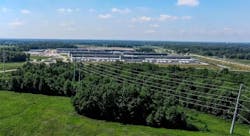AEP, Hyperscalers, Data Center Coalition Mull Energy Tariff Plan for Ohio Cloud Cluster
In Ohio, the rapid expansion of data centers by hyperscalers Google, Microsoft, Amazon, and Meta, along with increased development from colocation and smaller data center operators, has set power providers on edge.
So much so that back in May of 2024, American Electric Power of Ohio (AEP) tried to get ahead of the curve by filing a proposal with the public utilities commission of Ohio (PUCO) to create a new rate category for data center customers and cryptocurrency mining/mobile data center operations.
According to Marc Reitter, AEP Ohio President and Chief Operating Officer, the issue wasn’t so much about current customers, but the need to have accurate plans and commitments from large data center customers in order to assure that the right facilities were built at the right times.
Currently, the power demand in central Ohio, a hotspot of data center development, is expected to more than double over the next five years, and building new power generation and transmission facilities can take 7-10 years.
Proposed New Utility Rate Structure
The AEP proposal to PUCO was such that data centers would be required to pay for 90% of the power they planned to use, even if their eventual needs didn’t hit their preconstruction estimates.
The proposed rate structure would apply to new data centers with planned loads greater than 25 MW and to cryptocurrency mining operations/mobile data centers with loads greater than 1 MW. The agreement would need to be in place prior to the start of construction.
The proposal, to say the least, was not well accepted by the industry, with testimony before the PUCO describing it as discriminatory, unreasonable, and a major change from standard practices.
In response, a proposal from a group of leading data center stakeholders proposed paying for a minimum of 75% of the planned power usage, a proposal the AEP Ohio said failed to include other important provisions to protect consumers and some problematic inclusions overall.
It's unlikely that the proposed changes came as a surprise to the industry, as many executives in the business have expressed the concern that if data centers didn’t start addressing these power demand issues, the power companies would do it for them. This AEP Ohio proposal could just be the tip of the iceberg.
Data Center Coalition Files Joint Stipulation with PUCO
On October 10, the Data Center Coalition (DCC), a membership association for leading data center owners and operators devoted to public policy advocacy, announced it had signed onto a Joint Stipulation and Recommendation before PUCO in Case No. 24-0508-EL-ATA.
The DCC said the Joint Stipulation was the result of a collaborative negotiation process involving all parties and that the majority of parties in the case signed onto it. The signatory parties represent a broad coalition of Ohio businesses and other stakeholders. As noted by DCC, most of the signatory parties are not data center organizations. In addition to DCC, the signatory parties include:
Amazon Data Services, Inc.
Constellation Energy Generation, LLC and Constellation New Energy, Inc.
Enchanted Rock, LLC
Google LLC
Interstate Gas Supply
Microsoft Corporation
Ohio Blockchain Council
Ohio Energy Leadership Council
Ohio Manufacturers’ Association Energy Group
One Energy Enterprises, Inc.
Retail Energy Supply Association
Sidecat LLC, an affiliate of Meta Platforms, Inc.
Although the Joint Stipulation garnered support from a majority of the parties involved in the case, DCC noted that PUCO would need to review it thoroughly to make a decision on whether to approve it in whole or in part.
Per a DCC, an outline of the plan is thus:
"The Joint Stipulation seeks approval of a new Electricity-Intensive Customer (“EIC”) tariff schedule aimed at ensuring that energy-intensive customers, such as data centers, have heightened commitments to address potential transmission capacity constraints.
It addresses key concerns raised in AEP Ohio’s unprecedented application, including: (1) creating long-term contractual commitments for EIC customers; (2) materially increasing the minimum demand charge for Schedule EIC customers; and (3) creating heightened collateral requirements for certain EIC customers based on load characteristics.
The stipulation also includes a request for the PUCO to initiate a Commission-Ordered Investigation (COI) into grid-enhancing technologies and other solutions that could alleviate near term system capacity constraints in Central Ohio at a faster pace and lower cost than relying entirely on new transmission investments."
DCC President Josh Levi added the following statement:
“DCC is proud to be part of a broad coalition of industry leaders working collaboratively to address today’s challenges by building the grid of the future and supporting access to reliable and affordable electricity for all Ohio customers.
This collaborative filing puts forth a practical, evidence-based solution that provides necessary assurances to the utility, protects customers, and supports economic development in Ohio. It represents a strong vision for Ohio’s energy future – one where we can harness the power of innovation and work together to build a grid that benefits everyone.
By exploring grid-enhancing technologies, we can unlock cost savings for customers, attract greater economic investment, and continue to build upon Ohio’s exciting momentum as a growing hub of technology and industrial manufacturing. DCC will continue to lean in as a constructive partner in building a stronger, more resilient energy future for Ohio.”
A Compromise Reached, Or At Least Attempted
As of October 23, 2024, AEP Ohio filed aa settlement agreement to address these power demands.
Joined in the PUCO filing by staff of the Public Utilities Commission of Ohio, the Ohio Consumers’ Counsel (OCC), the Ohio Energy Group (OEG), Ohio Partners for Affordable Energy, and Walmart, the compromise starts with a requirement that those new 25 MW+ data centers pay 85% of their planned power usage.
Along with requirements to prove that their project is financially viable and a requirement to pay an exit fee if the project is cancelled or unable to meet other contractual terms.
These requirements would be in place for 12 years with a 4 year ramp-up period, but also includes an outline for a process to end the current moratorium on new agreements on central Ohio data centers.
Small and mid-size data centers would be able to use a sliding scale that provides additional flexibility.
Other provisions that have been proposed included incentives for energy efficient development, adjustable usage provisions based on actual usage, and a shared cost model between the stakeholders, including AEP Ohio and the data centers.
The proposal is still up in the air; however, as the hearing scheduled for November 4th, 2024 has been rescheduled for December 3, 2024 to give interested parties, both pro and con, additional time to provide evidentiary materials supporting their arguments.
Details on the ongoing process can be found here.
Striking a Balance
Ultimately, the settlement will represent a delicate balancing act. It needs to protect the growth of central Ohio as a hub for data centers and tech investments, while also addressing the interests of its residents.
The agreement’s success will depend on whether it can support a sustainable balance, encouraging the technology industry and its investment in continued expansion.
We'll continue following this story. How the discussion evolves should be of interest to the data center industry, as this framework could be a model for other markets where cost sharing for transmission expansions are at issue.
About the Author

David Chernicoff
Matt Vincent
A B2B technology journalist and editor with more than two decades of experience, Matt Vincent is Editor in Chief of Data Center Frontier.



